
The finite square well
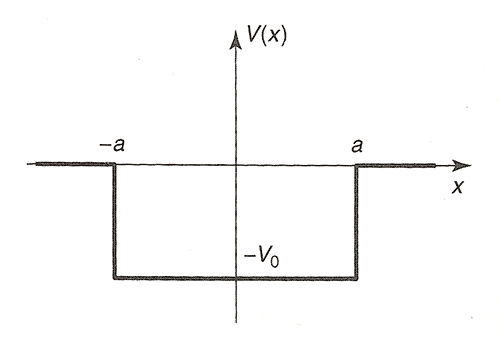
$$V(x)=\left\{
\begin{array}{ll}
-V_0 &\ \ \ |x| \leq a\\0 &\ \ \ |x|\gt a
\end{array}
\right.
$$
This potential should have both bound ($-V_0\lt E\lt 0$) and scattering ($0\lt E$) states:
Bound states: $E\lt 0$
In the two regions $|x|\gt a$, $V(x)=0$, so Schrödinger says: $$-\frac{\hbar^2}{2m}\frac{d^2\varphi}{dx^2} =E\varphi\ \ \text{or }\frac{d^2\varphi}{dx^2}=\kappa^2 \varphi,$$ where $\kappa=\sqrt{-2mE}/\hbar$ is real and positive. There are two solutions in each region, but to make sure that $\varphi(x)\to 0$ as $x\to \pm\infty$, we will have: $$\varphi(x)=\left\{\begin{array}{ll} Be^{\kappa x} &\ \ \ x \lt -a\\ Fe^{-\kappa x} &\ \ \ a \lt x \end{array}\right.$$
In the well $|x|\leq a$, $V(x)=-V_0$, so Schrödinger says: $$-\frac{\hbar^2}{2m}\frac{d^2\varphi}{dx^2}-V_0\varphi =E\varphi\ \ \text{or }\frac{d^2\varphi}{dx^2}=-l^2 \varphi,$$ where $l=\sqrt{2m(E+V_0)}/\hbar$ is real and positive. There are two solutions and we'll write the general solution as a superposition of the form: $$\varphi(x)=C\sin lx + D\cos lx.$$
Taking advantage of the symmetry (the potential well is even) we'll work with the half-well potential
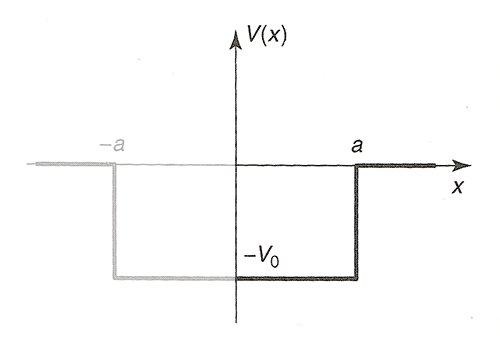
and look for even solutions where $\varphi(-x)=\varphi(x)$. [I'll leave the odd ones for you...]
The even solutions in the well are the ones where $C=0$ and $\varphi(x)=D\cos lx$.
Applying the boundary conditions...
Continuity of the wave function $\varphi(x)$ at $x=a$: $$Fe^{-\kappa a}=D\cos la.$$
Continuity of the slope, $\varphi'(x)$ at $x=a$: $$-\kappa Fe^{-\kappa a}=-l D\sin la.$$
Dividing the two equations: $$\kappa = l \tan la,$$
and re-arranging: $$\begineq \frac{\kappa }{l} &= \tan la \\ \sqrt{\frac{-2mE/\hbar^2}{2m(E+V_0)/\hbar^2}} &= \tan\left( \sqrt{2mE+V_0}a/\hbar\right)\\ \sqrt{\frac{2mV_0-2m(E+V_0)}{2m(E+V_0)}} &= \tan\left( \sqrt{2mE+V_0}a/\hbar\right)\\ \sqrt{(z_0/z)^2-1} &= \tan z\\ \endeq $$ where $z=\sqrt{2m(E+V_0)}\frac a\hbar$ and $z_0=\sqrt{2mV_0}\frac a\hbar$. This is a transcendental equation in one variable, $z$.
For bound states, $E \lt 0$ and we know there are no solutions when the energy is below the bottom of the well. $E+V_0$ is the energy of the state above the bottom of the well:
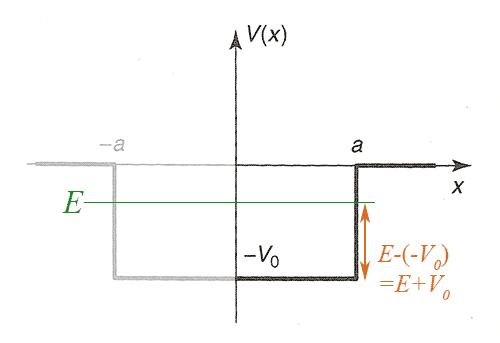
The ratio
$$(z_0/z)^2=\frac{V_0}{E+V_0}$$
is always greater than one.
Increasing $z_0=\sqrt{2mV_0}a/\hbar$ corresponds to a deeper and/or wider well.
[Graphical solution of $\sqrt{(z_0/z)^2-1} =
\tan z$.]
The graph of $g(z)=\sqrt{(z_0/z)^2-1}$ is 0 when $z=z_0$.
A couple things to notice:
- $z_0\to 0 \equiv$ (shallow / wide well):
It would appear that there is always at least one even, bound state, even for a vanishingly shallow well.
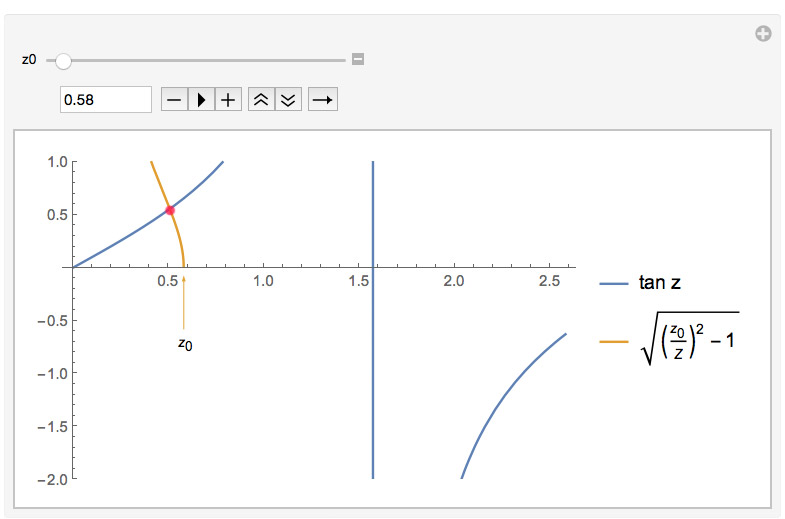
- $z_0\to \text{large} \equiv$ (deep / narrow well):
The solutions (particularly for the states close to the ground state) are very close to, but less than the vertical lines at $$z=\frac{\pi}{2},\frac{3\pi}{2},\frac{5\pi}{2},\frac{7\pi}{2},...$$ or $z_n=n\pi/2$ for odd values of $n$.
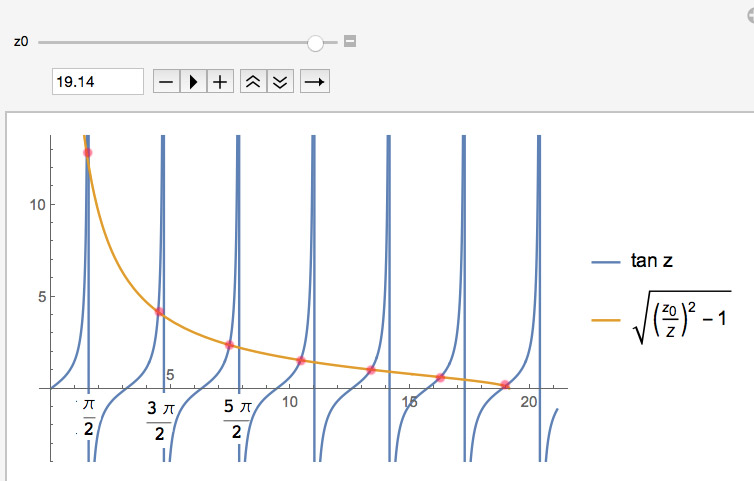
Since $z\equiv la=\frac{\sqrt{2m(E+V_0)}}{\hbar}a$ this implies $$E_n+V_0\approx \frac{n^2 \pi^2 \hbar^2}{2ma(2a)^2}=E_{\infty n}$$ That is, the solutions have energies(*) which are approximately equal to(**) the energies(***) of the stationary states of the infinite square well(****).
!!
* $E+V_0$ is the energy of a state above the bottom of the finite square well.
** but slightly less than,
*** with $n$ odd.
**** the infinite square well of width $2a$.
Homework
Read section 5.5, "FINITE SQUARE WELL". McIntyre has a different convention than I used for the potential, and he arranges the transcendental equation differently than I did. I like his approach, because one of the functions to be graphed is a circle! But the results should be the same.
Of course, you will really learn this when you do it. So, follow what he does in section 5.5 while you work on problem 5.15, which is to find (and graph) the transcendental equation for the odd functions. See our homework page (Chapter 5 problems) for some notes on the problems, and additional questions.
Work these problems in Chapter 5: 15, 16, 17, 23 (easier), (24)